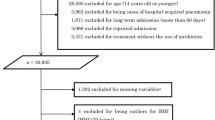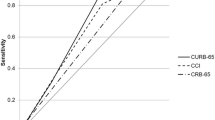Abstract
OBJECTIVE: To compare the performances of a disease-specific severity of illness index and a prototypical generic severity of illness measure, MedisGroups Admission Severity Groups (ASGs), for patients with community-acquired pneumonia.
DESIGN: A retrospective database study.
PATIENTS: Adult patients (aged ≥ 18 years) with an ICD-9-CM principal diagnosis of pneumonia in 78 MedisGroups Comparative Database hospitals.
METHODS: The pneumonia severity of illness index (PSI) was developed to predict hospital mortality using logistic regression analyses in a 70% random sample of study patients. The performances of the PSI and the generic severity measure were assessed among the remaining 30% of patients by comparing observed mortalities within the five PSI and ASG severity classes, and areas under their receiver operating characteristic (ROC) curves. Both the PSI and the generic severity measure were used to estimate the 95% confidence interval of the expected number of deaths in each of the 78 study hospitals. Hospitals with an observed number of deaths outside these limits were identified as outliers.
RESULTS: There were 14,199 study patients who had community-acquired pneumonia, and 1,542 (10.9%) died during hospitalization. In comparison with the generic severity measure, the PSI more accurately identified patients at extremely low risk of death, and had a larger area under its ROC curve (0.84 vs 0.79; p<0.0001). Of the 78 study hospitals, 17 (21.8%) were classified as outliers for mortality by at least one severity adjustment system. Among the 11 low-outlier hospitals, six were classified by the generic severity measure alone, two by the PSI alone, and three by both systems; among the six high-outlier hospitals, one was classified by the generic measure alone, three by the PSI alone, and two by both systems.
CONCLUSIONS: The PSI provided more accurate estimates of hospital mortality and classified different hospital outliers for mortality than did the generic severity of illness measure for patients with community-acquired pneumonia.
Similar content being viewed by others
References
Brewster AC, Karlin BG, Hyde LA, et al. MEDISGRPS: a clinically based approach to classifying hospital patients at admission. Inquiry. 1985; 12:377–87.
Knaus WA, Draper EA, Wagner DP, Zimmerman JE. APACHE II: a severity of disease classification system. Crit Care Med. 1985;13:818–29.
Young WW, Swinkola RB, Zorn DM. The measure of hospital case mix. Med Care. 1982;20: 501–12.
Charlson ME, Pompei P, Ales KL, MacKenzie CR. A new method of classifying prognostic comorbidity in longitudinal studies: development and validation. J Chron Dis. 1987; 40:373–83.
Horn SD, Horn RA. The computerized severity index. A new tool for casemix adjustment. J Med Systems. 1986;10:73–8.
Conklin JE, Lieberman JV, Barnes CA, Louis DZ. Disease staging: implications for hospital reimbursement and management. Health Care Fin Rev. 1984;(suppl):13–22.
Kaplan MH, Feinstein AR. The importance of classifying initial comorbidity in the evaluation of outcomes of diabetes mellitus. J Chron Dis. 1974;27:387–404.
Iezzoni LI. Severity of illness measures. Comments and caveats. Med Care. 1990;28:757–61.
Iezzoni LI, Moskowitz MA. A clinical assessment of MedisGroups. JAMA. 1988;260:3159–63.
Hospital Effectiveness Report. Harrisburg, PA: Pennsylvania Health Care Cost Containment Council, 1990;3. Publication HE5-4-88.
Hospital Effectiveness Report Technical Notes. Harrisburg, PA: Pennsylvania Health Care Cost Containment Council, 1990;4B. Publication HE 1-89.
Blumberg MS. Biased estimates of expected acute myocardial infarction mortality using MedisGroups admission severity groups. JAMA. 1991;265:2965–70.
Daley J, Jencks S, Draper D, Lenhart G, Thomas N, Walker J. Predicting hospital-associated mortality for Medicare patients. A method for patients with stroke, pneumonia, acute myocardial infarction, and congestive heart failure. JAMA. 1988;260:3617–24.
Iezzoni LI, Ash AS, Coffman GA, Moskowitz MA. Predicting in-hospital mortality. A comparison of severity measurement approaches. Med Care. 1992; 30:347–59.
Thomas JN, Ashcraft MCF, Zimmerman J. An evaluation of alternate severity of illness measures for use by university hospitals. In: Management Summary, Vol I. Ann Arbor, MI: Ann Arbor Department of Health Services Management and Policy, School of Public Health, University of Michigan, 1986;1–13.
Fine MJ, Singer DE, Hanusa BH, Lave JR. Kapoor WN. Validation of a pneumonia prognostic index using the MedisGroups Comparative Hospital Database. Am J Med. 1993; 94:153–9.
Fine MJ, Orloff JJ, Arisumi D, et al. Prognosis of patients hospitalized with community-acquired pneumonia. Am J Med. 1990; 88(suppl):5-lN–5-8N.
Fine MJ. Hospitalization decision in patients with community-acquired pneumonia: a prospective cohort study. Am J Med. 1990;89:713- 21.
Research Committee of the British Thoracic Society and the Public Health Laboratory Service. Community-acquired pneumonia in adults in British hospitals in 1982-1983: a survey of aetiology, mortality, prognostic factors and outcome. Q J Med. 1987;62:195–220.
Keeler EB, Kahn KL, Draper D, et al. Changes in sickness at admission following the introduction of the prospective payment system. JAMA. 1990;264: 1962–8.
Macfarlane JT. Adverse prognostic factors in pneumonia. Thorax. 1983;38:231.
CART? California Statistical Software, Lafayette, CA, 1985.
Hanley JA, McNeil BJ. The meaning and use of the area under a receiver operating characteristic (ROC) curve. Radiology. 1982;, 143: 29–36.
Selker HP. Systems for comparing actual and predicted mortality rates: characteristics to promote cooperation in improving hospital care. Ann Intern Med. 1993;118:820–2.
Goldberg HI, Cummings MA. Conducting medical effectiveness research: a report from the inter- PORT work groups. Med Care. 1994;32(7 suppl):JSl-JS4.
Kahn KL, Brook RH, Draper D, et al. Interpreting hospital mortality data. JAMA. 1988;260:3625–8.
Jencks SF, Daley J, Draper D, Thomas N, Lenhart G, Walker J. Interpreting hospital mortality data. JAMA. 1988;260:3611–6.
Iezzoni LI, Ash AS, Coffman GA, Moskowitz MA. Admission and mid-stay MedisGroups scores as predictors of death within 30 days of hospital admission. Am J Public Health. 1991;81:74–8.
Author information
Authors and Affiliations
Additional information
Supported in part by the Agency for Health Care Policy and Research as part of the Pneumonia Patient Outcomes Research Team (PORT) Project (RO1 HS 06468). Dr. Fine is supported as a Robert Wood Johnson Foundation Generalist Physician Faculty Scholar.
Rights and permissions
About this article
Cite this article
Fine, M.J., Hanusa, B.H., Lave, J.R. et al. Comparison of a disease-specific and a generic severity of illness measure for patients with community-acquired pneumonia. J Gen Intern Med 10, 359–368 (1995). https://doi.org/10.1007/BF02599830
Published:
Issue Date:
DOI: https://doi.org/10.1007/BF02599830




